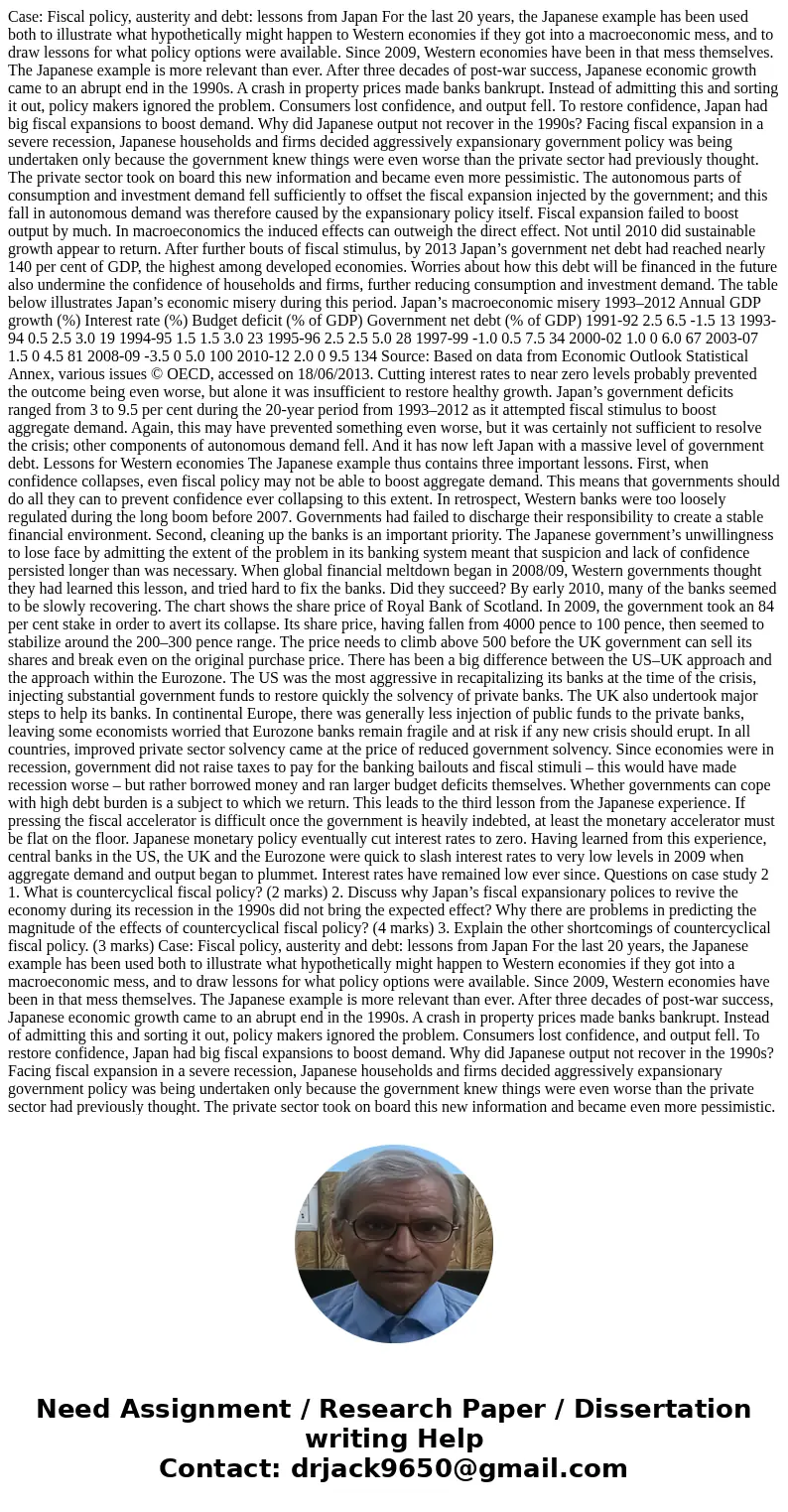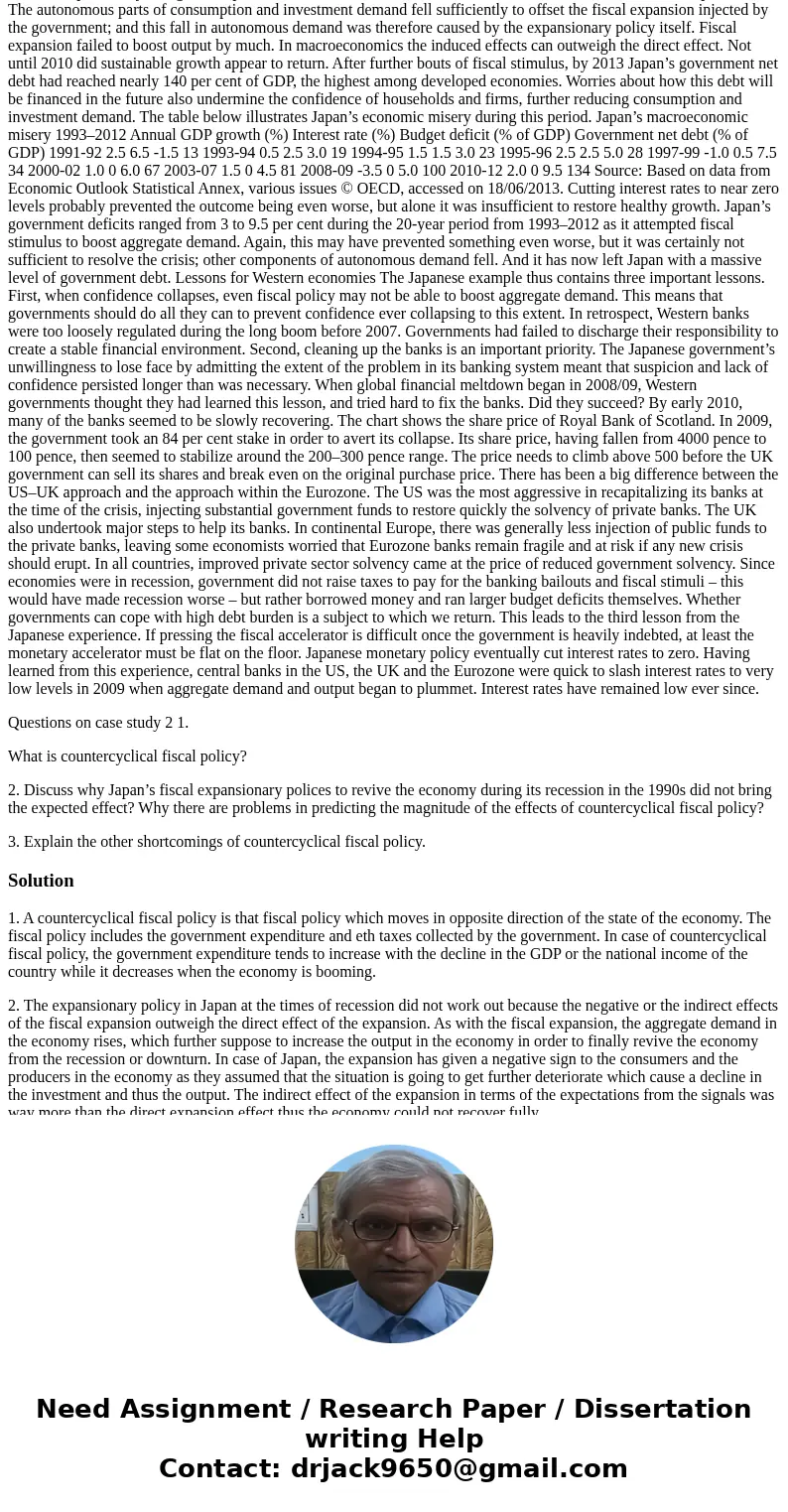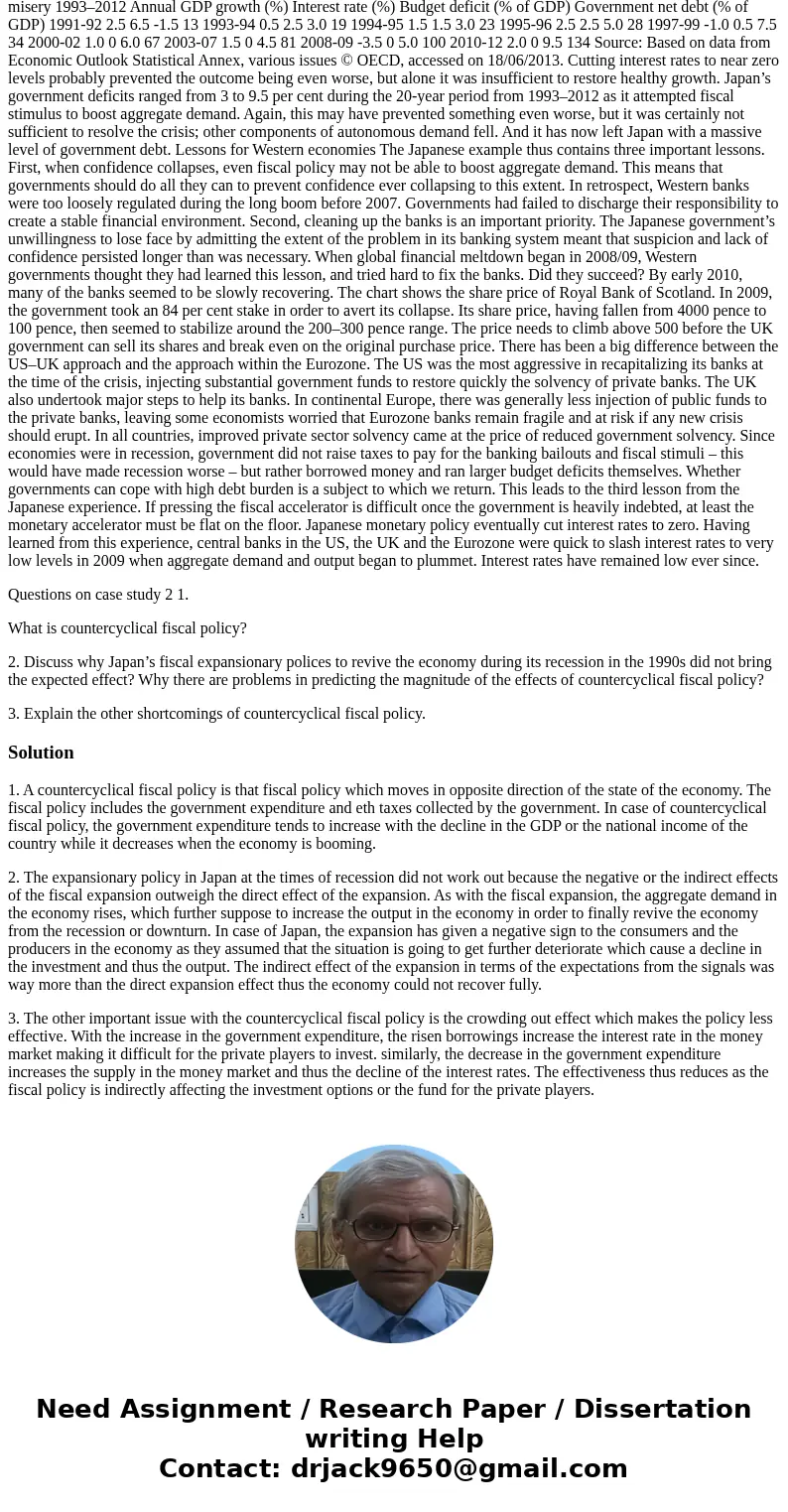Case Fiscal policy austerity and debt lessons from Japan For
Case: Fiscal policy, austerity and debt: lessons from Japan For the last 20 years, the Japanese example has been used both to illustrate what hypothetically might happen to Western economies if they got into a macroeconomic mess, and to draw lessons for what policy options were available. Since 2009, Western economies have been in that mess themselves. The Japanese example is more relevant than ever. After three decades of post-war success, Japanese economic growth came to an abrupt end in the 1990s. A crash in property prices made banks bankrupt. Instead of admitting this and sorting it out, policy makers ignored the problem. Consumers lost confidence, and output fell. To restore confidence, Japan had big fiscal expansions to boost demand. Why did Japanese output not recover in the 1990s? Facing fiscal expansion in a severe recession, Japanese households and firms decided aggressively expansionary government policy was being undertaken only because the government knew things were even worse than the private sector had previously thought. The private sector took on board this new information and became even more pessimistic. The autonomous parts of consumption and investment demand fell sufficiently to offset the fiscal expansion injected by the government; and this fall in autonomous demand was therefore caused by the expansionary policy itself. Fiscal expansion failed to boost output by much. In macroeconomics the induced effects can outweigh the direct effect. Not until 2010 did sustainable growth appear to return. After further bouts of fiscal stimulus, by 2013 Japan’s government net debt had reached nearly 140 per cent of GDP, the highest among developed economies. Worries about how this debt will be financed in the future also undermine the confidence of households and firms, further reducing consumption and investment demand. The table below illustrates Japan’s economic misery during this period. Japan’s macroeconomic misery 1993–2012 Annual GDP growth (%) Interest rate (%) Budget deficit (% of GDP) Government net debt (% of GDP) 1991-92 2.5 6.5 -1.5 13 1993-94 0.5 2.5 3.0 19 1994-95 1.5 1.5 3.0 23 1995-96 2.5 2.5 5.0 28 1997-99 -1.0 0.5 7.5 34 2000-02 1.0 0 6.0 67 2003-07 1.5 0 4.5 81 2008-09 -3.5 0 5.0 100 2010-12 2.0 0 9.5 134 Source: Based on data from Economic Outlook Statistical Annex, various issues © OECD, accessed on 18/06/2013. Cutting interest rates to near zero levels probably prevented the outcome being even worse, but alone it was insufficient to restore healthy growth. Japan’s government deficits ranged from 3 to 9.5 per cent during the 20-year period from 1993–2012 as it attempted fiscal stimulus to boost aggregate demand. Again, this may have prevented something even worse, but it was certainly not sufficient to resolve the crisis; other components of autonomous demand fell. And it has now left Japan with a massive level of government debt. Lessons for Western economies The Japanese example thus contains three important lessons. First, when confidence collapses, even fiscal policy may not be able to boost aggregate demand. This means that governments should do all they can to prevent confidence ever collapsing to this extent. In retrospect, Western banks were too loosely regulated during the long boom before 2007. Governments had failed to discharge their responsibility to create a stable financial environment. Second, cleaning up the banks is an important priority. The Japanese government’s unwillingness to lose face by admitting the extent of the problem in its banking system meant that suspicion and lack of confidence persisted longer than was necessary. When global financial meltdown began in 2008/09, Western governments thought they had learned this lesson, and tried hard to fix the banks. Did they succeed? By early 2010, many of the banks seemed to be slowly recovering. The chart shows the share price of Royal Bank of Scotland. In 2009, the government took an 84 per cent stake in order to avert its collapse. Its share price, having fallen from 4000 pence to 100 pence, then seemed to stabilize around the 200–300 pence range. The price needs to climb above 500 before the UK government can sell its shares and break even on the original purchase price. There has been a big difference between the US–UK approach and the approach within the Eurozone. The US was the most aggressive in recapitalizing its banks at the time of the crisis, injecting substantial government funds to restore quickly the solvency of private banks. The UK also undertook major steps to help its banks. In continental Europe, there was generally less injection of public funds to the private banks, leaving some economists worried that Eurozone banks remain fragile and at risk if any new crisis should erupt. In all countries, improved private sector solvency came at the price of reduced government solvency. Since economies were in recession, government did not raise taxes to pay for the banking bailouts and fiscal stimuli – this would have made recession worse – but rather borrowed money and ran larger budget deficits themselves. Whether governments can cope with high debt burden is a subject to which we return. This leads to the third lesson from the Japanese experience. If pressing the fiscal accelerator is difficult once the government is heavily indebted, at least the monetary accelerator must be flat on the floor. Japanese monetary policy eventually cut interest rates to zero. Having learned from this experience, central banks in the US, the UK and the Eurozone were quick to slash interest rates to very low levels in 2009 when aggregate demand and output began to plummet. Interest rates have remained low ever since. Questions on case study 2 1. What is countercyclical fiscal policy? (2 marks) 2. Discuss why Japan’s fiscal expansionary polices to revive the economy during its recession in the 1990s did not bring the expected effect? Why there are problems in predicting the magnitude of the effects of countercyclical fiscal policy? (4 marks) 3. Explain the other shortcomings of countercyclical fiscal policy. (3 marks) Case: Fiscal policy, austerity and debt: lessons from Japan For the last 20 years, the Japanese example has been used both to illustrate what hypothetically might happen to Western economies if they got into a macroeconomic mess, and to draw lessons for what policy options were available. Since 2009, Western economies have been in that mess themselves. The Japanese example is more relevant than ever. After three decades of post-war success, Japanese economic growth came to an abrupt end in the 1990s. A crash in property prices made banks bankrupt. Instead of admitting this and sorting it out, policy makers ignored the problem. Consumers lost confidence, and output fell. To restore confidence, Japan had big fiscal expansions to boost demand. Why did Japanese output not recover in the 1990s? Facing fiscal expansion in a severe recession, Japanese households and firms decided aggressively expansionary government policy was being undertaken only because the government knew things were even worse than the private sector had previously thought. The private sector took on board this new information and became even more pessimistic. The autonomous parts of consumption and investment demand fell sufficiently to offset the fiscal expansion injected by the government; and this fall in autonomous demand was therefore caused by the expansionary policy itself. Fiscal expansion failed to boost output by much. In macroeconomics the induced effects can outweigh the direct effect. Not until 2010 did sustainable growth appear to return. After further bouts of fiscal stimulus, by 2013 Japan’s government net debt had reached nearly 140 per cent of GDP, the highest among developed economies. Worries about how this debt will be financed in the future also undermine the confidence of households and firms, further reducing consumption and investment demand. The table below illustrates Japan’s economic misery during this period. Japan’s macroeconomic misery 1993–2012 Annual GDP growth (%) Interest rate (%) Budget deficit (% of GDP) Government net debt (% of GDP) 1991-92 2.5 6.5 -1.5 13 1993-94 0.5 2.5 3.0 19 1994-95 1.5 1.5 3.0 23 1995-96 2.5 2.5 5.0 28 1997-99 -1.0 0.5 7.5 34 2000-02 1.0 0 6.0 67 2003-07 1.5 0 4.5 81 2008-09 -3.5 0 5.0 100 2010-12 2.0 0 9.5 134 Source: Based on data from Economic Outlook Statistical Annex, various issues © OECD, accessed on 18/06/2013. Cutting interest rates to near zero levels probably prevented the outcome being even worse, but alone it was insufficient to restore healthy growth. Japan’s government deficits ranged from 3 to 9.5 per cent during the 20-year period from 1993–2012 as it attempted fiscal stimulus to boost aggregate demand. Again, this may have prevented something even worse, but it was certainly not sufficient to resolve the crisis; other components of autonomous demand fell. And it has now left Japan with a massive level of government debt. Lessons for Western economies The Japanese example thus contains three important lessons. First, when confidence collapses, even fiscal policy may not be able to boost aggregate demand. This means that governments should do all they can to prevent confidence ever collapsing to this extent. In retrospect, Western banks were too loosely regulated during the long boom before 2007. Governments had failed to discharge their responsibility to create a stable financial environment. Second, cleaning up the banks is an important priority. The Japanese government’s unwillingness to lose face by admitting the extent of the problem in its banking system meant that suspicion and lack of confidence persisted longer than was necessary. When global financial meltdown began in 2008/09, Western governments thought they had learned this lesson, and tried hard to fix the banks. Did they succeed? By early 2010, many of the banks seemed to be slowly recovering. The chart shows the share price of Royal Bank of Scotland. In 2009, the government took an 84 per cent stake in order to avert its collapse. Its share price, having fallen from 4000 pence to 100 pence, then seemed to stabilize around the 200–300 pence range. The price needs to climb above 500 before the UK government can sell its shares and break even on the original purchase price. There has been a big difference between the US–UK approach and the approach within the Eurozone. The US was the most aggressive in recapitalizing its banks at the time of the crisis, injecting substantial government funds to restore quickly the solvency of private banks. The UK also undertook major steps to help its banks. In continental Europe, there was generally less injection of public funds to the private banks, leaving some economists worried that Eurozone banks remain fragile and at risk if any new crisis should erupt. In all countries, improved private sector solvency came at the price of reduced government solvency. Since economies were in recession, government did not raise taxes to pay for the banking bailouts and fiscal stimuli – this would have made recession worse – but rather borrowed money and ran larger budget deficits themselves. Whether governments can cope with high debt burden is a subject to which we return. This leads to the third lesson from the Japanese experience. If pressing the fiscal accelerator is difficult once the government is heavily indebted, at least the monetary accelerator must be flat on the floor. Japanese monetary policy eventually cut interest rates to zero. Having learned from this experience, central banks in the US, the UK and the Eurozone were quick to slash interest rates to very low levels in 2009 when aggregate demand and output began to plummet. Interest rates have remained low ever since.
Questions on case study 2 1.
What is countercyclical fiscal policy?
2. Discuss why Japan’s fiscal expansionary polices to revive the economy during its recession in the 1990s did not bring the expected effect? Why there are problems in predicting the magnitude of the effects of countercyclical fiscal policy?
3. Explain the other shortcomings of countercyclical fiscal policy.
Solution
1. A countercyclical fiscal policy is that fiscal policy which moves in opposite direction of the state of the economy. The fiscal policy includes the government expenditure and eth taxes collected by the government. In case of countercyclical fiscal policy, the government expenditure tends to increase with the decline in the GDP or the national income of the country while it decreases when the economy is booming.
2. The expansionary policy in Japan at the times of recession did not work out because the negative or the indirect effects of the fiscal expansion outweigh the direct effect of the expansion. As with the fiscal expansion, the aggregate demand in the economy rises, which further suppose to increase the output in the economy in order to finally revive the economy from the recession or downturn. In case of Japan, the expansion has given a negative sign to the consumers and the producers in the economy as they assumed that the situation is going to get further deteriorate which cause a decline in the investment and thus the output. The indirect effect of the expansion in terms of the expectations from the signals was way more than the direct expansion effect thus the economy could not recover fully.
3. The other important issue with the countercyclical fiscal policy is the crowding out effect which makes the policy less effective. With the increase in the government expenditure, the risen borrowings increase the interest rate in the money market making it difficult for the private players to invest. similarly, the decrease in the government expenditure increases the supply in the money market and thus the decline of the interest rates. The effectiveness thus reduces as the fiscal policy is indirectly affecting the investment options or the fund for the private players.



 Homework Sourse
Homework Sourse